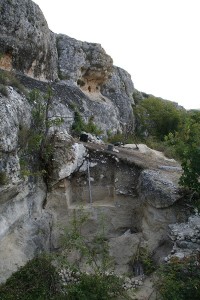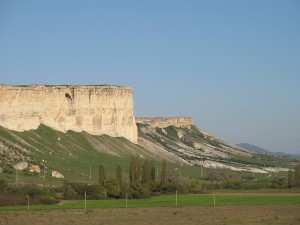On the trail of the last Neanderthals

FAU researchers look for answers on the extinction of the pre-human
Approximately 250,000 years ago, the Neanderthals ruled Europe, but 40,000 years ago is when their trail goes cold for us. Some experts claims that particularly cool periods during the last Ice Age caused their extinction where others suggest that the migration of the Homo sapiens into Europe forced our relatives away. Remains found on the Crimean Peninsula on the coast of the Black Sea contradict these theses, as several factors indicate that Neanderthals and modern humans co-existed for a long time. A team from Friedrich-Alexander-Universität Erlangen-Nürnberg (FAU) is following the trail of the pre-humans on the coast of the Black Sea and conducting field research to fill in gaps in our knowledge of the last Neanderthals.
‘Remains found on the Crimean Peninsula are dated much later than Neanderthal findings elsewhere,’ explains Prof. Dr. Thorsten Uthmeier from the Institute of Prehistory and Early History at FAU, who is leading the project. Researchers have already excavated typical tools, hunting remains and fire places at several locations which can be linked directly to the Neanderthals through burial findings with identical remains. Carbon dating of the remains has revealed that they are approximately 10,000 years more recent than all other remains found in the entire habitat of the Neanderthal – an area ranging from the Iberian Peninsula to Siberia.
Researchers have also found tools belonging to Neanderthals and modern humans in the same strata. This reveals that both species inhabited the Crimean Peninsula either at the same time or closely after one another. While researchers had previously assumed that Neanderthals and modern humans had only co-existed once approximately 60,000 years ago in the Middle East, it now seems that this could have happened much later on the Crimean Peninsula too – a unique scenario in Europe. ‘Researchers have not yet paid much attention to where Neanderthals may have migrated as modern humans came to Europe. We want to change this,’ explains Uthmeier.
When did Neanderthals meet Homo sapiens?

This summer, researchers from the Institute of Prehistory and Early History at FAU and the Archaeological Institute of the National Academy of Sciences of Ukraine will start on three years of excavations across several sites. The excavations of a Neanderthal hunting camp and a rock shelter will be compared with the remains of a site inhabited by early modern humans to reveal how the pre-humans became extinct. FAU’s research team will be supported by earth scientists from the Universities of Bayreuth, Greifswald and Zurich. The researchers will reopen previous excavations of Neanderthal and Homo sapiens remains to narrow down the period in which Neanderthals and modern humans may have co-existed. Technical innovations will help the researchers to make new discoveries. Modern carbon dating means that bones can be dated with greater precision than only a few years ago. The researchers will also investigate the age of charcoal samples.
The researchers hope that a particular circumstance will yield unique insight into Neanderthals: the pre-human and Homo sapiens co-existed in close geographic proximity on the Crimean Peninsula, meaning they were exposed to the same environmental conditions. How did both species deal with these conditions? The remains of stone tools and hunting remains will be used to reconstruct the ways of life of both human species. Thanks to the project conditions, the researchers are expecting to discover whether the Neanderthals had a competitive disadvantage through less effective or sustainable use of their environment or whether another social or physical factor contributed to their extinction. Overall, the FAU research team and its partners in Germany and Ukraine are hoping to contribute new findings on the survival and extinction of the last Neanderthals and the proliferation of modern humans in western Eurasia.
Further information:
Prof. Dr. Thorsten Uthmeier
Phone: +49 (0)9131 85 22346
thorsten.uthmeier@ufg.phil.uni-erlangen.de